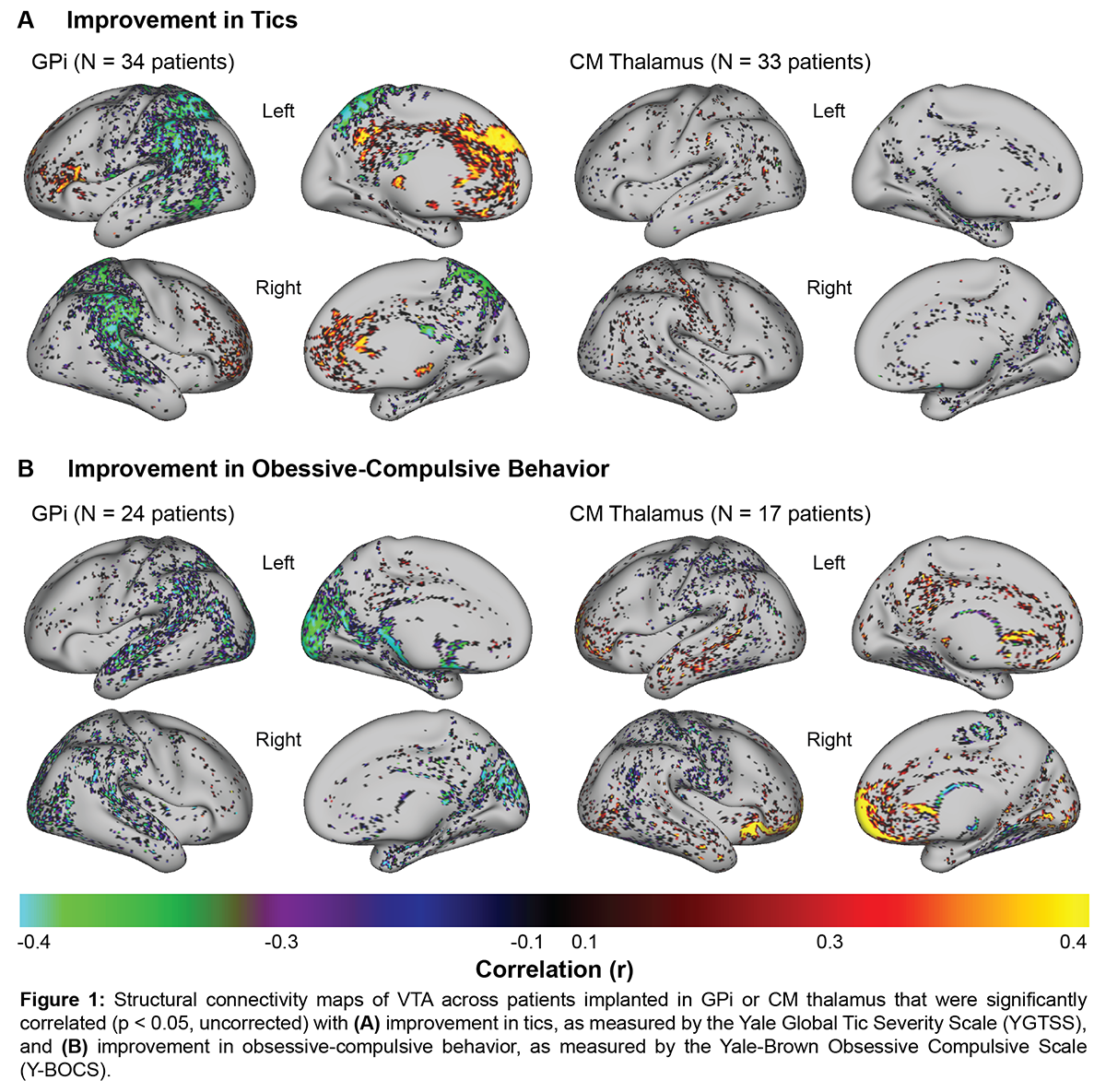Session Information
Date: Tuesday, September 24, 2019
Session Title: Tics/Tourette
Session Time: 1:45pm-3:15pm
Location: Les Muses Terrace, Level 3
Objective: The objective of this study was to identify the structural connectivity correlates of improvement in tics and obsessive-compulsive behavior (OCB) following deep brain stimulation (DBS) for Tourette syndrome (TS).
Background: Centromedial (CM) thalamus or globus pallidus internus (GPi) can be effective DBS targets for severe, treatment-refractory TS. Clinical responses to DBS vary substantially across TS patients and it is unknown if there are structural networks that are associated with improvements in tics or OCB.
Method: Retrospective pre- and post-operative imaging, Yale Global Tic Severity Scale (YGTSS) scores, and Yale-Brown Obsessive Compulsive Scale (Y-BOCS) scores of TS DBS patients (N = 67) were collected in a collaboration with the International TS DBS Database and Registry [1] and the International Neuromodulation Registry [2]. Bilateral volumes of tissue activated (VTA) were generated using stimulation parameters for each patient. The VTA were used to generate probabilistic tractography in diffusion-weighted imaging of 40 Human Connectome Project subjects [3][4]. Voxel-wise linear regression was performed to identify regions where structural connectivity was significantly correlated (p < 0.05) with percent improvement in YGTSS or Y-BOCS scores.
Results: Across patients implanted in GPi (N = 34), voxels in medial prefrontal cortex (mPFC), lateral PFC, cingulate cortex (CC), orbitofrontal cortex (OFC), primary motor cortex (M1), supplementary motor area (SMA), and parietal cortex were significantly correlated with improvements in YGTSS. Voxels in the parietal cortex, temporal cortex, and ventral striatum (VS) were significantly correlated with improvements in Y-BOCS. Across patients implanted in CM thalamus (N = 33), voxels in CC, parietal cortex, temporal cortex, and occipital cortex were significantly correlated with improvements in YGTSS. Voxels in OFC, mPFC, VS, SMA, M1, and sensory cortex were significantly correlated with improvements in Y-BOCS.[figure1]
Conclusion: The results suggest that regions with structural connections to the VTA are correlated with improvements in tics or OCB in TS patients and these regions differ across DBS targets. Several of the brain regions correlated with symptom improvement have been previously implicated in TS pathology. Future work will include studying if modulating the cortical regions associated with clinical improvement could provide similar benefit.
References: [1] Martinez-Ramirez D, Jiminez-Shahed J, Leckman JF, et al. Efficacy and Safety of Deep Brain Stimulation in Tourette Syndrome The International Tourette Syndrome Deep Brain Stimulation Public Database and Registry. JAMA Neurol 2018;32607:1–7. [2] Hedges DM, Hegman JC, Chapman BE, Butson CR. The International Neuromodulation Registry: an informatics framework supporting cohort discovery and analysis. Frontiers in Neuroinformatics 2019; submitted. [3] Van Essen DC, Smith SM, Barch DM, et al. The WU-Minn Human Connectome Project: An Overview. NeuroImage 2008;80:62–79. [4] Glasser MF, Stamatios NS, Wilson JA, et al. The Minimal Preprocessing Pipelines for the Human Connectome Project. NeuroImage 2013;80:105–24.
To cite this abstract in AMA style:
K. Johnson, G. Duffley, D. Servello, A. Bona, M. Porta, J. Ostrem, E. Bardinet, M-L. Welter, A. Lozano, J. Baldermann, J. Kuhn, D. Huys, T. Foltynie, M. Hariz, E. Joyce, L. Zrinzo, Z. Kefalopoulou, J-G. Zhang, F-G. Meng, CC. Zhang, Z. Ling, X. Xu, X. Yu, A. Smeets, L. Ackermans, V. Visser-Vandewalle, A. Mogilner, M. Pourfar, L. Almeida, A. Gunduz, W. Hu, K. Foote, M. Okun, C. Butson. Structural Connectivity Predicts Clinical Outcomes of Deep Brain Stimulation for Tourette Syndrome [abstract]. Mov Disord. 2019; 34 (suppl 2). https://www.mdsabstracts.org/abstract/structural-connectivity-predicts-clinical-outcomes-of-deep-brain-stimulation-for-tourette-syndrome/. Accessed April 21, 2025.« Back to 2019 International Congress
MDS Abstracts - https://www.mdsabstracts.org/abstract/structural-connectivity-predicts-clinical-outcomes-of-deep-brain-stimulation-for-tourette-syndrome/

